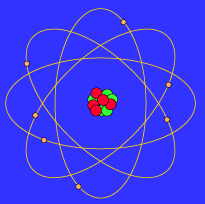Assigning all atoms an oxidation state of zero serves as an important reference point, as oxidation-reduction reactions always involve a change in the oxidation state of the atoms or ions involved. This change in oxidation state is due to the "loss" or "gain" of electrons. The loss of electrons from an atom produces a positive oxidation state, while the gain of electrons results in negative oxidation states.
The changes that occur in the oxidation state of certain elements can be predicted quickly and accurately by the use of simple guidelines. These guidelines are based on the behavior of the Representative Elements, which can be divided into two classes; the metals and nonmetals.
All metal atoms are characterized by their tendency to be oxidized, losing one or more electrons, forming a positively charged ion, called a cation. During this oxidation reaction , the oxidation state of the metal always increases from zero to a positive number, such as "+1, +2, +3...." , depending on the number of electrons lost. The number of electrons lost by these Representative metals and the charge of the cation formed are always equal to the Group number of the metal as summarized below.
Group
Number Number ofElectrons Lost Charge ofCation Formed
I 1 +1
II 2 +2
III 3 +3
IV 4 +4
The group numbers also correspond to the electrons that are found in the outermost energy levels of these atoms. These electrons are often called valence electrons.
By convention oxidation reactions are written in the following form using the element, Calcium, as an example

Note that the oxidation state increases from zero to a positive number (from "0" to "+2" in the above example) and is always numerically equal to the number of electrons lost. See Exercise 1
The electrons lost by the metal are not destroyed but gained by the nonmetal, which is said to be reduced. As the nonmetal gains the electrons lost by the metal, it forms a negatively charged ion, called an anion. During this reduction reaction, the oxidation state of the nonmetal always decreases from zero to a negative value (-1, -2, -3 ...) depending on the number of electrons gained. The number of electrons gained by any Representative nonmetal and the charge of the anion formed, can be predicted by use of the following guidelines.
Group
Number Number ofElectrons Gained Charge ofAnion Formed
IV 4 -4
V 3 -3
VI 2 -2
VII 1 -1
VIII 0 no tendency to form anions
Note, the GROUP VIII nonmetals have no tendency to gain additional electrons, hence they are unreactive in terms of oxidation-reduction. This is one the reasons why this family of elements was originally called the Inert Gases.
By convention reduction reactions are written in the following way: 
Note that the charge of anion formed is always numerically equal to the number of electrons gained. See exercise 2
One important fact to remember in studying oxidation-reduction reactions is that the process of oxidation cannot occur without a corresponding reduction reaction. Oxidation must always be "coupled" with reduction, and the electrons that are "lost" by one substance must always be "gained" by another as matter (such as electrons) cannot be destroyed or created. Hence, the terms "lost or gained", simply mean that the electrons are being transferred from one particle to another.



No comments:
Post a Comment